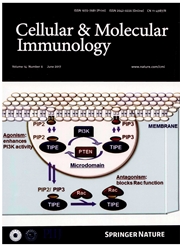

 中文摘要:
中文摘要:
cytokine 发信号的 Suppressor (SOCS ) 1 在有免疫力的反应和力量起一个关键作用贡献与 glucocorticoid 对待的肝失败的预测。我们招募了接受 glucocorticoid 治疗和 30 健康控制在外部血 mononuclear 房间在 SOCS1 的 transcriptional 水平上决定 glucocorticoid 的潜在的效果的 47 个 acute-on-chronic 肝炎 B 肝失败(ACHBLF ) 病人。在 glucocorticoid 治疗的第三和八分之二十天, SOCS1 表示否定地为结束阶段肝疾病与模型一起被相关(吞没) 分数。Interleukin-6 (IL-6 ) 和肿瘤坏死 factor-α;(TNF-α;) 层次统计上更低,当 SOCS1 抄写水平在预告的处理和处理以后的 ACHBLF 病人两个都比非幸存者在幸存者是更高的时。在 ACHBLF 病人的 SOCS1 倡导者的 methylation 率比在由 methylation 特定的聚合酶链反应决定了的健康控制病人高。在 methylated 倡导者的 SOCS1 的 mRNA 水平是比从与 unmethylated SOCS1 倡导者一起的病人显著地低的。干扰素(IFN )-γ-responsive 和 STAT1 依赖的基因表示在幸存者是更高的并且戏剧性地在 glucocorticoid 治疗以后与 SOCS1 的升起的表示被减少。没有 methylation,死亡率比为那些在 methylated 病人是显著地更高的。而且,我们在六发现了五熬过病人在治疗以后在八分之二十天显示了 demethylated SOCS1,当那个数字在非幸存者在 10 是 3 时。这些调查结果建议没有 SOCS1 methylation 的 ACHBLF 病人可以有有利回答到 corticosteroid 治疗。
 英文摘要:
英文摘要:
Suppressor of cytokine signaling (SOCS) 1 plays a crucial role in the immune response and might contribute to the prognoses of liver failure treated with glucocorticoid. We recruited 47 acute-on-chronic hepatitis B liver failure (ACHBLF) patients receiving glucocorticoid treatment and 30 healthy controls to determine the potential effects of glucocorticoid on the transcriptional level of SOCS1 in peripheral blood mononuclear cells. On the third and twenty-eighth days of glucocorticoid treatment, SOCS1 expression was negatively correlated with model for end-stage liver disease (MELD) score. Interleukin-6 (IL-6) and tumor-necrosis factor-a ('I'NF-a) levels were statistically lower, while the SOCS1 transcription level was higher in survivors than non-survivors both in pre- and post-treatment ACHBLF patients. The methylation rate of the SOCS1 promoter in ACHBLF patients was higher than in healthy control patients as determined by methylation-specific polymerase chain reaction. The mRNA level of SOCS1 in methylated promoters was significantly lower than from patients with unmethylated SOCS1 promoters, interferon (IFN)-y-responsive and STATl-dependent gene expression was higher in survivors and was dramatically decreased with rising expression of SOCS1 after glucocorticoid treatment. Mortality rates were significantly higher in methylated patients than for those without methylation at the end of a 90-day follow-up. Furthermore, we found that five in six surviving patients displayed demethylated SOCS1 on the twenty-eighth day after treatment, while that number was 3 in 10 in the non-survivors. These findings suggested that ACHBLF patients without SOCS1 methylation may have a favorable response to corticosteroid treatment.
 同期刊论文项目
同期刊论文项目
 同项目期刊论文
同项目期刊论文
 Increased peripheral RORalpha and RORgammat mRNA expression is associated with acute-on-chronic hepa
Increased peripheral RORalpha and RORgammat mRNA expression is associated with acute-on-chronic hepa DNA methylation patterns of peroxisome proliferator-activated receptor gamma gene associated with li
DNA methylation patterns of peroxisome proliferator-activated receptor gamma gene associated with li Promoter methylation status and expression of PPAR-gamma gene are associated with prognosis of acute
Promoter methylation status and expression of PPAR-gamma gene are associated with prognosis of acute Demethylation of tumor necrosis factor-alpha converting enzyme promoter associated with high hepatit
Demethylation of tumor necrosis factor-alpha converting enzyme promoter associated with high hepatit Prognoses of patients with acute-on-chronic hepatitis B liver failure are closely associated with al
Prognoses of patients with acute-on-chronic hepatitis B liver failure are closely associated with al Elevated expression of tumour necrosis factor-alpha-induced protein 8 (TNFAIP8)-like 2 mRNA in perip
Elevated expression of tumour necrosis factor-alpha-induced protein 8 (TNFAIP8)-like 2 mRNA in perip Aberrant DNA Methylation of G-protein-coupled Bile Acid Receptor Gpbar1 (TGR5) is a Potential Biomar
Aberrant DNA Methylation of G-protein-coupled Bile Acid Receptor Gpbar1 (TGR5) is a Potential Biomar Methylation of serum insulin-like growth factor-binding protein 7 promoter in hepatitis B virus-asso
Methylation of serum insulin-like growth factor-binding protein 7 promoter in hepatitis B virus-asso DNA methylation patterns of PPAR gamma gene associated with liver fibrosis and inflammation in chron
DNA methylation patterns of PPAR gamma gene associated with liver fibrosis and inflammation in chron Increased A20 mRNA Level in Peripheral Blood Mononuclear Cells is Associated With Immune Phases of P
Increased A20 mRNA Level in Peripheral Blood Mononuclear Cells is Associated With Immune Phases of P Sera DNA Methylation of CDH1, DNMT3b and ESR1 Promoters as Biomarker for the Early Diagnosis of Hepa
Sera DNA Methylation of CDH1, DNMT3b and ESR1 Promoters as Biomarker for the Early Diagnosis of Hepa Aberrant DNA methylation of G-protein-coupled bile acid receptor Gpbar1 predicts prognosis of acute-
Aberrant DNA methylation of G-protein-coupled bile acid receptor Gpbar1 predicts prognosis of acute- Methylation of suppressor of cytokine signalling 1 gene promoter is associated with acute-on-chronic
Methylation of suppressor of cytokine signalling 1 gene promoter is associated with acute-on-chronic Association between Ras association domain family 1A promoter methylation and hepatocellular carcino
Association between Ras association domain family 1A promoter methylation and hepatocellular carcino Exportin 4 gene expression and DNA promoter methylation status in chronic hepatitis B virus infectio
Exportin 4 gene expression and DNA promoter methylation status in chronic hepatitis B virus infectio Comparison of intramuscular compound betamethasone and oral diclofenac sodium in the treatment of ac
Comparison of intramuscular compound betamethasone and oral diclofenac sodium in the treatment of ac Methylation of the Glutathione-S-Transferase P1 Gene Promoter Is Associated with Oxidative Stress in
Methylation of the Glutathione-S-Transferase P1 Gene Promoter Is Associated with Oxidative Stress in Up-regulation of A20 gene expression in peripheral blood mononuclear cells is associated with acute-
Up-regulation of A20 gene expression in peripheral blood mononuclear cells is associated with acute- A model to predict antiviral treatment in HBeAg negative chronic hepatitis B with alanine aminotrans
A model to predict antiviral treatment in HBeAg negative chronic hepatitis B with alanine aminotrans TIPE2 mRNA Level in PBMCs Serves as a Novel Biomarker for Predicting Short-Term Mortality of Acute-o
TIPE2 mRNA Level in PBMCs Serves as a Novel Biomarker for Predicting Short-Term Mortality of Acute-o Methylation of tissue factor pathway inhibitor 2 as a prognostic biomarker for hepatocellular carcin
Methylation of tissue factor pathway inhibitor 2 as a prognostic biomarker for hepatocellular carcin Overexpression of serum sST2 is associated with poor prognosis in acute-on-chronic hepatitis B liver
Overexpression of serum sST2 is associated with poor prognosis in acute-on-chronic hepatitis B liver 期刊信息
期刊信息
